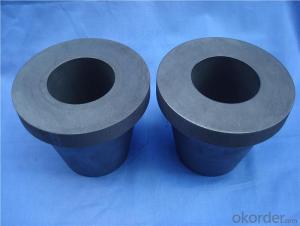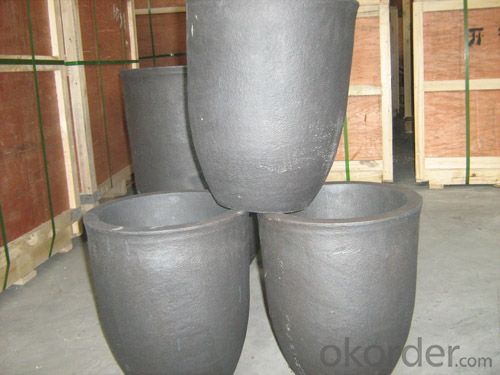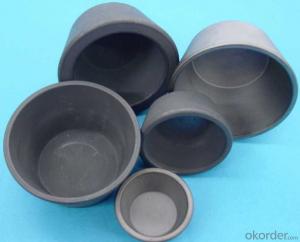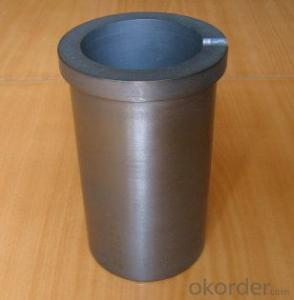Graphite Crucibles/CNBM China High Carbon
- Loading Port:
- China main port
- Payment Terms:
- TT OR LC
- Min Order Qty:
- 0 m.t.
- Supply Capability:
- 100000 m.t./month
OKorder Service Pledge
OKorder Financial Service
You Might Also Like
Feature
1.Long working lifetime: its working lifetime is increased 3-5 times over normal clay-crucible due to the compact body formed under high pressure.
2.High thermal conductivity: highdensity body and low apparent porosity greatly improve its heat conductivity.
3.Newstyle materials: new heat conduction material ensures faster heat conductivity and pollution-free product, reduces adherent slag.
4.Resistance to corrosion:better anti-corrosion than normal clay-crucible.
5.Resistance to oxidation: advanced process dramatically improves its oxidation resistance, which ensures persistent heat conductivity and long working lifetime.
6.High-strength: high-density body and logical structure make the product better compression property.
7.Eco-friendly: energy-efficient and pollution-free, not only ensure metal product purity, but also ensure sustainable development on environment.
8.Multi-function: Can be used in induction graphite crucible furnace
Specification
Bulk Density | g/cc | 1.70-1.88 |
Specific Resistance | μΩ.m | 6.0-15.0 |
Compressive Strength | MPa | 30-80 |
Bending Strength | MPa | 20-45 |
Shore hardness | 30-70 | |
C.T.E.(100-600°C) | x10-6 /°C | 2.5-5.5 |
Ash | % | 0.01-0.2 |
Maximum Grain Size | mm | 0.044-0 |
Picture


- Q: How does carbon impact the availability of clean water resources?
- The availability of clean water resources can be significantly influenced by carbon. One way carbon affects water resources is by contributing to climate change. The burning of fossil fuels, mainly responsible for increased carbon emissions, leads to higher global temperatures and disrupts the water cycle. This disruption results in more frequent and severe droughts in certain regions, while others face increased rainfall and flooding. The melting of glaciers and snowpacks, which are essential sources of freshwater for many communities, is also affected by climate change. As carbon emissions warm the planet, glaciers and snowpacks melt at an accelerated rate, reducing the water supply in rivers and streams that rely on these natural storages. This ultimately leads to water scarcity, affecting drinking water availability, agricultural irrigation, and industrial water usage. Moreover, the quality of water resources can be impacted by carbon pollution. Carbon dioxide dissolves in water and reacts with it, causing a decrease in pH levels and increased acidity. This process, known as ocean acidification, is particularly harmful to marine ecosystems and organisms that rely on carbonate ions to build their shells or skeletons. As these organisms struggle to survive, it disrupts the balance of entire aquatic ecosystems, which then affects the availability of clean water resources. Additionally, carbon-based pollutants from human activities, such as industrial processes or agricultural runoff, can contaminate water sources. Pesticides, fertilizers, and hydrocarbons, which are carbon-based chemicals, can infiltrate groundwater or be washed into rivers and lakes, compromising their quality and rendering them unsuitable for drinking or other uses. In conclusion, the impact of carbon on the availability of clean water resources is complex. It affects the quantity of water through changes in the water cycle, reduces water quality through acidification and pollution, and disrupts ecosystems that rely on water resources. Addressing carbon emissions and mitigating climate change is crucial to protect and ensure the availability of clean water for current and future generations.
- Q: I just decoration, do not understand, JS run, please feel free to show.
- LED gold tube Yuba, tinghuo... Carbon fiber was a real fire last year
- Q: How does carbon monoxide affect air quality and human health?
- Carbon monoxide (CO) is a colorless, odorless gas that can have detrimental effects on both air quality and human health. It is primarily released into the atmosphere through incomplete combustion of fossil fuels and biomass burning. In terms of air quality, high levels of carbon monoxide contribute to the formation of ground-level ozone and smog, which can impair visibility and cause respiratory issues. When it comes to human health, carbon monoxide is particularly concerning as it binds to hemoglobin in our red blood cells, preventing oxygen from being delivered to vital organs and tissues. This can lead to symptoms such as headaches, dizziness, confusion, and in severe cases, even death. Individuals with cardiovascular and respiratory conditions, as well as unborn babies and the elderly, are especially vulnerable to the harmful effects of carbon monoxide exposure. Therefore, proper ventilation and the use of carbon monoxide detectors are crucial to prevent its accumulation and protect both air quality and human health.
- Q: Often see a lot of cars made of carbon fiber body, is this material flammable?
- Carbon fiber has the characteristics of light quality, high strength and not easy to burn. More and more widely used
- Q: What are the impacts of carbon emissions on the spread of infectious diseases?
- Carbon emissions have a significant impact on the spread of infectious diseases. The burning of fossil fuels, such as coal, oil, and natural gas, releases large amounts of carbon dioxide (CO2) and other greenhouse gases into the atmosphere. These emissions contribute to climate change, which in turn affects the distribution and transmission of various infectious diseases. One of the main ways carbon emissions influence the spread of infectious diseases is through changes in temperature. Rising global temperatures create favorable conditions for the survival and proliferation of disease-causing agents and their vectors. For example, warmer temperatures can expand the geographic range of disease-carrying insects like mosquitoes, which are responsible for transmitting diseases such as malaria, dengue fever, and Zika virus. Additionally, climate change caused by carbon emissions can disrupt ecosystems and alter the behavior of animals that serve as hosts or reservoirs for infectious diseases. Changes in migration patterns, breeding cycles, and hibernation can affect the dynamics of diseases, making them more difficult to control. For instance, warmer temperatures may lead to the expansion of tick populations, increasing the risk of tick-borne diseases like Lyme disease. Furthermore, carbon emissions contribute to air pollution, which has adverse effects on respiratory health. Pollutants like particulate matter and nitrogen dioxide can weaken the immune system and make individuals more susceptible to respiratory infections, including influenza and pneumonia. These pollutants also exacerbate the severity of respiratory symptoms in individuals already infected with respiratory diseases. The impacts of carbon emissions on the spread of infectious diseases are not limited to direct effects on humans. Changes in climate patterns can disrupt agricultural systems, leading to food insecurity and malnutrition. These conditions weaken the immune systems of vulnerable populations, making them more susceptible to infectious diseases. It is important to recognize the connection between carbon emissions and the spread of infectious diseases in order to mitigate their impacts. Reducing carbon emissions through transitioning to cleaner energy sources and implementing sustainable practices can help mitigate climate change and limit the expansion of disease vectors. Additionally, investing in public health infrastructure and surveillance systems can enhance our ability to detect and respond to outbreaks, minimizing their spread and impact on human populations.
- Q: There are ten carbon and oil Gulu chorus, carbon English Gollum and finally he said to sing, this is English this is the song of English is what?
- It's BAD AND NITHTDuring Halloween last year, many people joined in the chorusThe English sounds are are, you, ready and where you goingBecause the pronunciation and intonation is very interesting, so has been Tucao
- Q: Recently bought an alarm clock, it is recommended to use carbon batteries. Nanfu battery is not good for the movement.
- Nanfu is generally alkaline battery, the alarm clock movement, the power is too large, will damage the movement. Supermarkets generally have many brands of carbon batteries, you can follow their favorite and ability to buy. There are deer, wild horses, PHILPS and so on.
- Q: What's the difference between carbon steel pipes and stainless steel pipes and seamless steel tubes?
- As the name implies, carbon steel is made of carbon steel, forming mostly by welding, drawing, rolling, adopted the extrusion molding, and the steel tube drawing, rolling, extrusion molding are called seamless steel pipe welded steel pipe.
- Q: Is there a line cutting of carbon fibers?
- Your question is not clear. Do carbon fibers need to be cut with wire? Are carbon fiber composites? What type? In general, carbon fiber reinforced composites can not be cut by wire. They can be cut by ultrasonic and water cut
- Q: What is carbon black used for?
- Carbon black is a versatile substance that finds applications in various industries. Primarily, it is used as a pigment and reinforcing filler in the production of rubber products, such as tires, hoses, and belts. The addition of carbon black enhances the strength, durability, and resistance to abrasion of rubber materials. Additionally, carbon black is used as a coloring agent in inks, paints, and coatings due to its excellent light-absorbing properties. It provides intense black color and improves the UV resistance of these products. Moreover, carbon black is utilized in the production of plastics, where it acts as a filler to enhance the mechanical properties of plastic components and reduce their cost. In the energy sector, carbon black is employed as a conductive additive in batteries and fuel cells. Its high electrical conductivity enhances the performance of these energy storage devices. Carbon black is also used in the manufacture of electrodes for supercapacitors, where its large surface area enables efficient energy storage. Furthermore, carbon black has applications in the construction industry as a reinforcing agent in concrete and asphalt. It enhances the strength and durability of these materials, making them more resistant to cracking and weathering. In summary, carbon black is widely used in the production of rubber, plastics, inks, paints, coatings, batteries, fuel cells, supercapacitors, and construction materials. Its properties as a pigment, reinforcing filler, coloring agent, and conductive additive make it a valuable material in numerous industrial applications.
Send your message to us
Graphite Crucibles/CNBM China High Carbon
- Loading Port:
- China main port
- Payment Terms:
- TT OR LC
- Min Order Qty:
- 0 m.t.
- Supply Capability:
- 100000 m.t./month
OKorder Service Pledge
OKorder Financial Service
Similar products
Hot products
Hot Searches
Related keywords
























